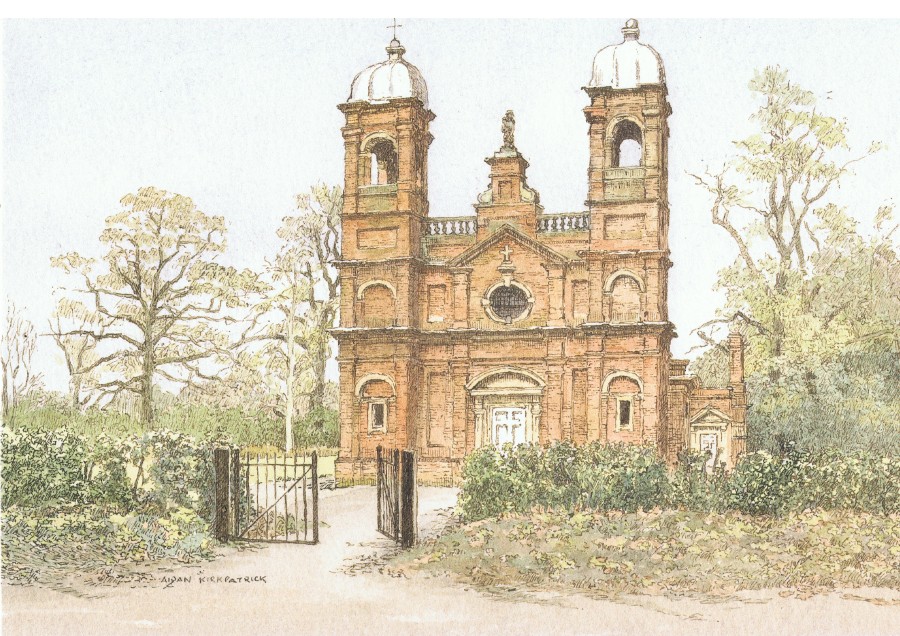John George Kenyon, 11 October 1843 – 28 July 1914
John George Kenyon was living in London (at 24, Dorset Square, NW1) when the sudden unexpected death of his aunt (Mrs Henry Eden, widow of Admiral Henry Eden), made him heir presumptive of Gillingham Hall. Greatly influenced by his friend Cardinal Newman, he had already converted to Catholicism (on 24th May, 1870). He had fought for Pope Pius IX against Garibaldi as a Zouave, and had also spent six months in the Regina Coeli prison in Rome. John George Kenyon was a Papal Chamberlain, and so was required to spend certain winter months in Rome.
The arrival of John George Kenyon in the area, in January 1889, combined with changes in other notable local families, encouraged Dom. Ephrem Guy O.S.B. (who had arrived in Bungay in 1885) to revive long-running attempts to found a Catholic mission at Beccles. He was aided in this by Dom. Edmund Ford O.S.B., both of them based in Bungay at the time.
Within a month of John George Kenyon and his wife arriving in Gillingham to take up their inheritance, Father Ephrem came to interview them and enlist their help (on 19th February 1889). The two men already knew each other, as John later recalled:
“On October 11th, 1886 we had the pleasure of a visit (at 24 Dorset Square) from Dom. Ephrem Guy O.S.B. I had made the acquaintance of this zealous priest in the October of 1870 when (as a member of the committee which had charge of the arrangements for welcoming the Canadian contingent of the Papal Zouaves on their way from Rome back to Canada after the seizure of Rome by the Piedmontese) I had to call upon him in Liverpool at St Anne’s and had found him a most sympathetic helper. It was a pleasure now to hear of projects for spreading the faith in the Eastern Counties and to renew acquaintance with him. Later on we corresponded more about the matter.”
John Kenyon responded to Fr. Guy with an initial donation of £500, plus a guarantee of £100 a year to support a priest at Beccles.
John Kenyon then purchased the land in Beccles on which now stands St Benet’s Minster, St Benet’s School, the school playing fields, the hall and the presbytery bungalow. The buildings now on the site (except the Minster itself) were gradually constructed with the money given by John Kenyon, and the site was vested in Downside. The original intention was to establish a small Benedictine community (with four or five monks) in Beccles.
Private family worship for the Kenyons took place in their own small chapel inside Gillingham Hall, nearby. Meanwhile, John Kenyon wished to have a church on his own land, and built Our Lady of Perpetual Succour as a Chapel of Ease to allow Catholic families in the village of Gillingham, many of whom worked on his estate, to worship regularly without having to travel all the way to Beccles. This church was not vested in Downside, but has always had its own Trustees, who are appointed by the family.
John Kenyon also bought a house in Grange Road, Beccles (near St Benets) for use by Dominican nuns, who arrived to work in the parish to staff the school which was built during this period by John Kenyon. This convent house was not vested in Downside, but in Our Lady of Perpetual Succour, Gillingham, which then had a small income from the rent for its maintenance.
After a change from the Dominicans to the Servites, the Poor Servants of the Mother of God arrived at Beccles, and were quite a large community then. They required larger premises, and acquired the house in Grange Road which had belonged to the architect Mr Banham (who had designed Bungay Church, St Benets, and OLPS Gillingham). Finally, the original convent was sold, and Ernest Arthur Bramley (husband of Mary Bramley, nee Todhunter, Trustee) invested the money in Charibonds for the benefit of OLPS Gillingham.
